2024届高考英语一轮复习谓语动词时态精讲课件(共32张PPT)
文档属性
| 名称 | 2024届高考英语一轮复习谓语动词时态精讲课件(共32张PPT) |  | |
| 格式 | pptx | ||
| 文件大小 | 1.7MB | ||
| 资源类型 | 教案 | ||
| 版本资源 | 通用版 | ||
| 科目 | 英语 | ||
| 更新时间 | 2024-02-20 12:26:14 | ||
图片预览


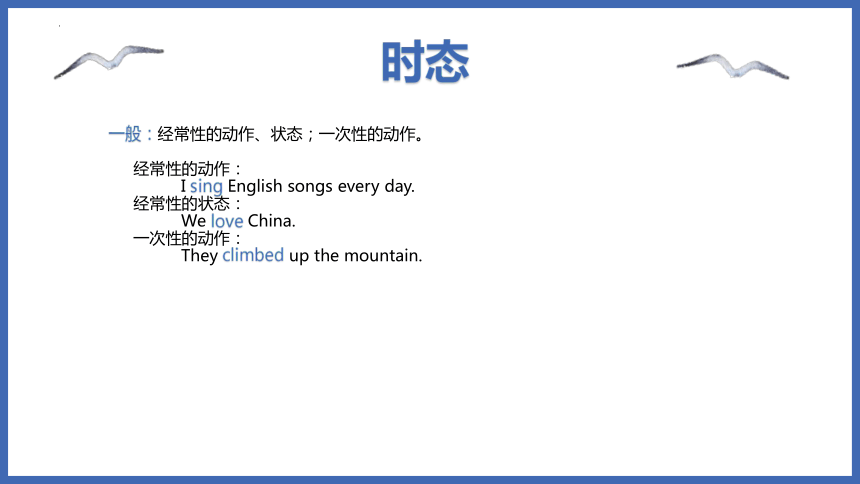
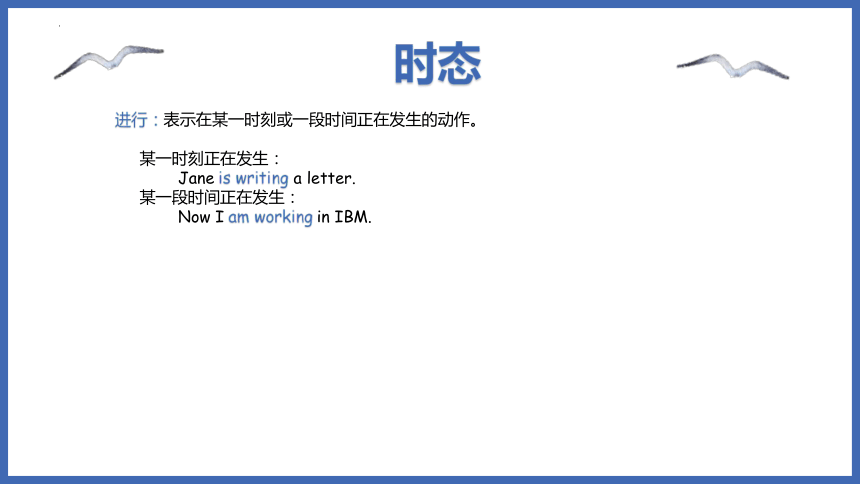
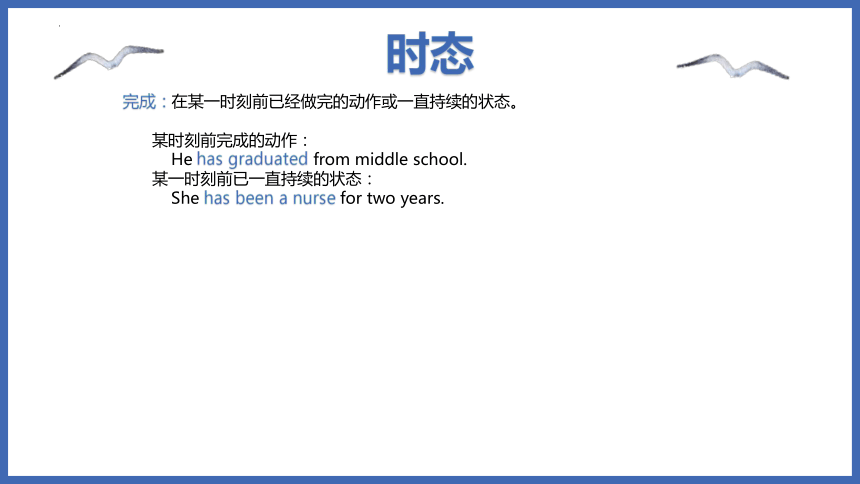

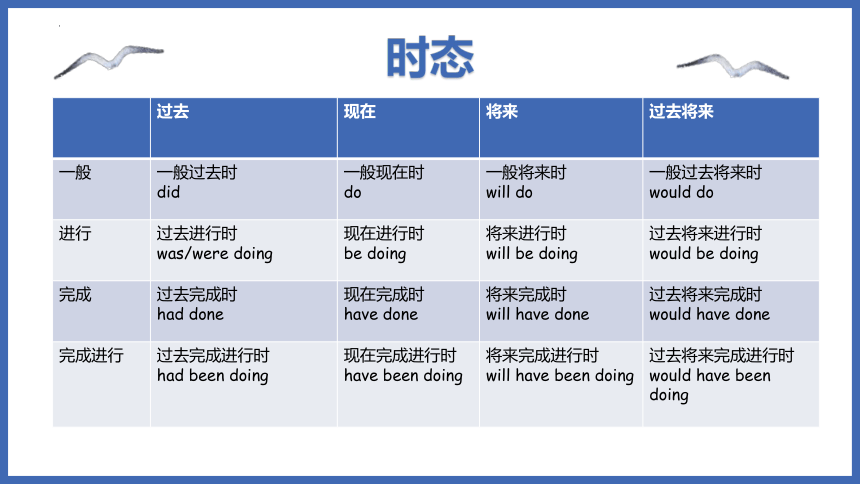
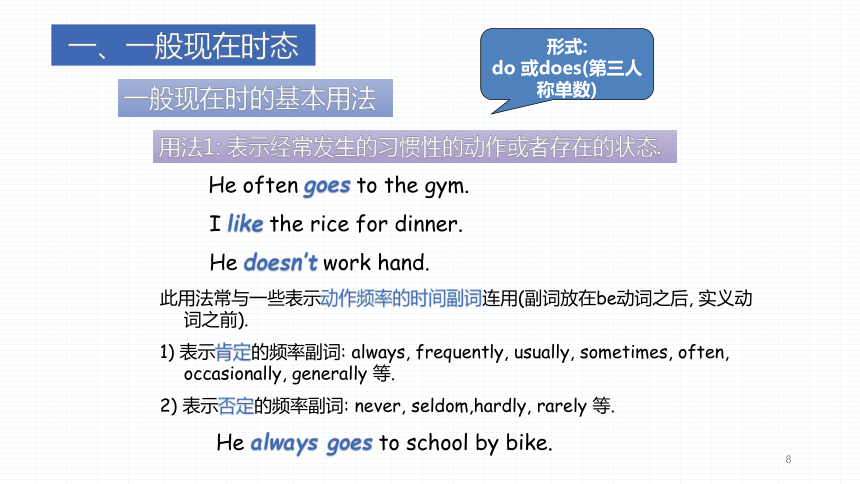
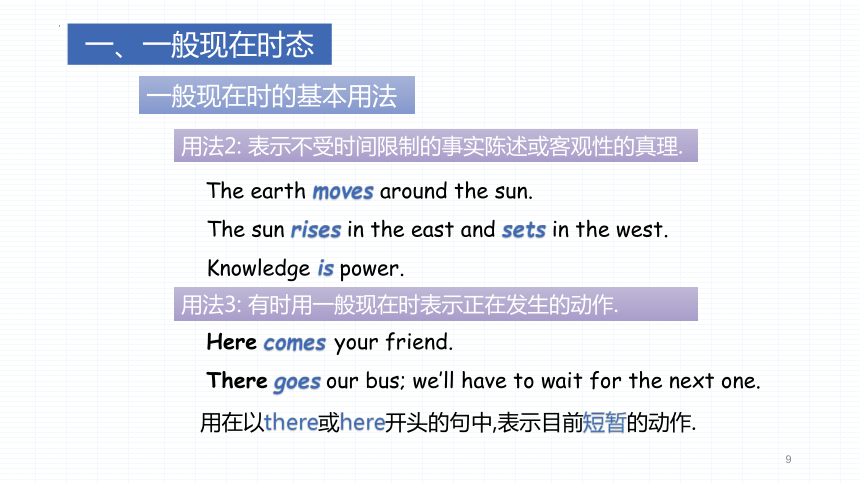
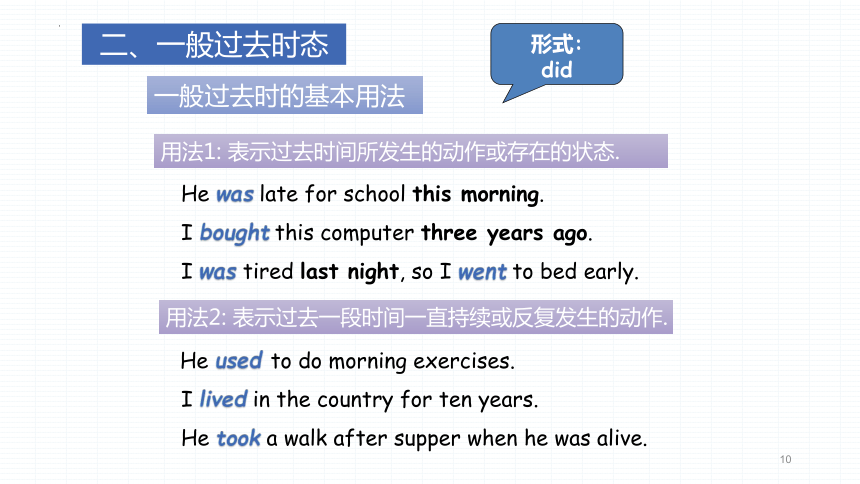
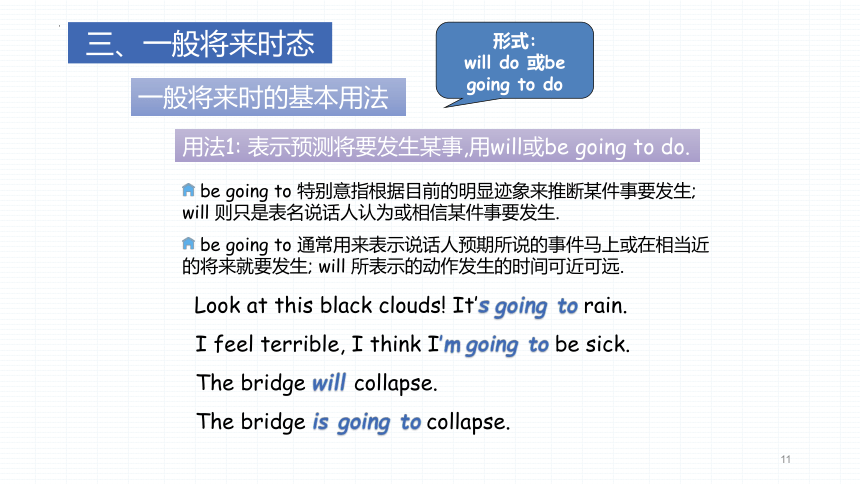

文档简介
(共32张PPT)
谓语动词时态
时态
时态=时间+状态
过去:指现在这时刻以前的某一时刻、某一 段时间或者所有过去时间。用动词的过去式表示过去。
现在:眼下这一时刻,或一段时间。这一时间伸缩性较大,可长可短。英语用动词原形或现在式表现在。
将来:指现在以后的任何时刻、时段或全部时间。用will或shall表示将来。
过去将来:在过去某时刻之后的时间。一般我们说将来是以现在为起点往未来看,而过去将来是将起点往过去移一步,即过去某时间的未来 ,比如前天是过去的,前天以后的任何时间都是前天的将来,昨天、今天、明天,以后任何时间都是前天的将来。英语用动词would表过去将来。
时态
一般:经常性的动作、状态;一次性的动作。
经常性的动作:
I sing English songs every day.
经常性的状态:
We love China.
一次性的动作:
They climbed up the mountain.
时态
进行:表示在某一时刻或一段时间正在发生的动作。
某一时刻正在发生:
Jane is writing a letter.
某一段时间正在发生:
Now I am working in IBM.
时态
完成:在某一时刻前已经做完的动作或一直持续的状态。
某时刻前完成的动作:
He has graduated from middle school.
某一时刻前已一直持续的状态:
She has been a nurse for two years.
时态
完成进行:表示动作从过去一直持续到某一个时刻,并且可能会继续持续下去。
What have you been doing just now
I have been playing basketball.
时态
过去 现在 将来 过去将来
一般 一般过去时 did 一般现在时 do 一般将来时 will do 一般过去将来时
would do
进行 过去进行时 was/were doing 现在进行时 be doing 将来进行时 will be doing 过去将来进行时
would be doing
完成 过去完成时 had done 现在完成时 have done 将来完成时 will have done 过去将来完成时
would have done
完成进行 过去完成进行时 had been doing 现在完成进行时 have been doing 将来完成进行时 will have been doing 过去将来完成进行时
would have been doing
8
一、一般现在时态
一般现在时的基本用法
用法1: 表示经常发生的习惯性的动作或者存在的状态.
He often goes to the gym.
I like the rice for dinner.
He doesn’t work hand.
形式:
do 或does(第三人称单数)
此用法常与一些表示动作频率的时间副词连用(副词放在be动词之后, 实义动词之前).
1) 表示肯定的频率副词: always, frequently, usually, sometimes, often, occasionally, generally 等.
2) 表示否定的频率副词: never, seldom,hardly, rarely 等.
He always goes to school by bike.
9
用法2: 表示不受时间限制的事实陈述或客观性的真理.
The earth moves around the sun.
The sun rises in the east and sets in the west.
Knowledge is power.
一、一般现在时态
一般现在时的基本用法
用法3: 有时用一般现在时表示正在发生的动作.
Here comes your friend.
There goes our bus; we’ll have to wait for the next one.
用在以there或here开头的句中,表示目前短暂的动作.
10
二、一般过去时态
一般过去时的基本用法
用法1: 表示过去时间所发生的动作或存在的状态.
形式:
did
He was late for school this morning.
I bought this computer three years ago.
I was tired last night, so I went to bed early.
用法2: 表示过去一段时间一直持续或反复发生的动作.
He used to do morning exercises.
I lived in the country for ten years.
He took a walk after supper when he was alive.
11
三、一般将来时态
一般将来时的基本用法
用法1: 表示预测将要发生某事,用will或be going to do.
形式:
will do 或be going to do
be going to 特别意指根据目前的明显迹象来推断某件事要发生; will 则只是表名说话人认为或相信某件事要发生.
be going to 通常用来表示说话人预期所说的事件马上或在相当近的将来就要发生; will 所表示的动作发生的时间可近可远.
Look at this black clouds! It’s going to rain.
I feel terrible, I think I’m going to be sick.
The bridge will collapse.
The bridge is going to collapse.
12
三、一般将来时态
一般将来时的基本用法
用法2: 表示行动计划时用be going to do;
表示意愿时用will.
be going to 表示说话人对未来行动的计划或打算, 通常是事先考虑并含有已经为这一行动作了某些准备的意思.
will 表示意愿,则表示在说话的时刻立即做出的决定, 表明将去做某事, 并没有经过事先考虑, 更没有为这一活动做出事先准备.
I have bought a computer and I’m going to learn the computer science.
Someone is knocking at the door. I’ll go and open it.
- I am thirsty.
- I will make you a hot cup of tea.
13
四、现在进行时态
现在进行时的基本用法
用法1: 表示说话此刻动作正在进行.
形式:
am/is/are + doing
He is not available now. he is talking on the phone.
Please don’t make so much noise. I am studying.
用法2: 表示现阶段正在持续的动作,说话时刻动作不一定正在发生.
These days I am translating a book.
I am feeding the neighbor’s cat this week while she’s in hospital.
Mr. Green is writing another novel.
14
四、现在进行时态
现在进行时的基本用法
用法3: 表示最近的将来一定的安排. 通常含有“计划”, “安排做”之意.
I am taking a makeup test tomorrow.
— what are you doing on Saturday night
— I’m doing some shopping with Jane.
用法4: 常与always, forever, continually, constantly 等连用,表示抱怨,厌烦, 不合情理或使人不愉快的事.
He’s always messing up the kitchen.
He’s continually asking me for money.
15
五、过去进行时态
过去进行时的基本用法
用法1: 用来描述一个过去特定的时刻正在发生的事情.
形式:
was/were + doing
I was discussing my thesis with my director at this time last night.
用法2: 常与一般过去时配合使用.此时,过去进行时通常表示一个历时较长的体系”背景”的动作或状态; 而一般过去时则表示此”背景”下发生的短暂的动作或状态.过去进行时动作先发生,一般过去时动作后发生.
I was watching TV when the phone rang.
I cut my finger when I was cooking the dinner last night.
16
六、将来进行时态
将来进行时的基本用法
用法1: 表示将来某一特定的时刻正在进行的动作.
形式:
will be doing
I’ll be lying on a beach in Sanya this time tomorrow.
Wait until seven o’clock so that they won’t still be eating.
Don’t call me at nine tomorrow because I will be studying at the library.
17
知识扩展:不用进行时的动词
1) 事实状态的动词:have, belong, possess, cost, owe, exist, include, contain, matter, weigh, measure, continue…
I have two brothers. This house belongs to my sister.
2) 心理状态的动词:know, realize, think see, believe, suppose, imagine, agree, recognize, remember, want, need, forget, prefer, mean, understand, love, hate…
I need your help. He loves her very much.
3) 瞬间动词:accept, receive, complete, finish, give, allow, decide, refuse…
I accept your advice.
4)系动词:seem, remain, lie, see, hear, smell, feel, taste, get, become, turn…
You seem a little tired.
18
现在完成时的基本用法
用法1: 延续到现在的动作或状态.
形式:
have/has done
七、现在完成时态
开始于过去的动作一直持续的现在,而且还可能继续持续下去。谓语动词一般为延续性动词。
I have lived here for 3 years.
The teacher has taught in this school since I came here.
Since time began, man has lived in fear of fire.
19
现在完成时的基本用法
用法2: 过去发生但与现在仍有联系的动作或状态.
七、现在完成时态
表示在不确定的过去发生的动作对现在仍有影响,谓语动词一般为短暂性动词。
He has broken his leg.
He broke his leg.
试比较
20
知识扩展:第二种现在完成时态使用技巧
1) 这种完成时态的肯定句不与“一段时间”的时间状语连用
He has left his hometown for 3 years. (典型错误)
He left his hometown 3 years ago.
He has been away from his hometown for 3 years.
Note: 短暂性动词的完成时句子若用否定句,表示尚未发生的事情,则可作为一种状态,表示延续。
I haven’t bought a pair of shoes for a year.
2) 与不确定时间的时间状语连用: already, yet, often, just, never...
He has already arrived. Has it stopped raining yet
3) 具有“新闻”性质,强调的是事件的内容,而不是事件发生的过去的具体时间
The President has been assassinated.
He can’t go on holiday because he has broken his leg.
21
现在完成时的基本用法
用法3: 到目前的一个时间段内重复发生的动作.
七、现在完成时态
表示到目前为止的一个时间段内重复发生的动作。
We have taken three tests so far this week.
I have made many new friends since I came to Changsha.
22
知识扩展:其他使用现在完成时的结构
1) This/That/It is+序数词+名词+that+现在完成时
It is the third time that I’ve come to Beijing.
It is the fifth time that someone has knocked at my door.
2) This/That/It is+最高级或only修饰名词+现在完成时
This is the most interesting movie that I’ve ever seen.
It is the worst book that I’ve ever read.
总之:现在完成时总是与现在有着密切的联系;或是表示到现在为止这一段时间的“一直在延续”或“重复发生”的动作或状态;或是表示影响现状的事件。
23
知识扩展:现在完成时和一般过去时比较
1) 现在完成时第二种用法表示的也是过去的动作或情况,强调过去的动作对现在的影响时才用现在完成时。
I haven’t seen him this morning.(说话时间this morning)
I didn’t see him this morning.(说话时间“今天晚上或下午”)
2) 在用于延续性动词时两个时态的区别
He has been in the army for 6 years. (他入伍以来已经6年了。)
He was in the army for 6 years. (他当过6年的兵,现在不是了。)
I have smoked for 2 years. (我有两年的烟龄了。)
I smoked for 2 years. (我抽了两年的烟,现在不抽了。)
24
过去完成时的基本用法
用法1: 开始于过去之前(即过去的过去)的动作或状态在过去这一时刻仍在进行.
八、过去完成时态
表示一个动作或状态在过去某一时间之前已经开始,这一动作或状态一直持续到这一过去时刻,并且到这一过去时刻还没有结束并仍有可能继续持续下去。
I had learned 1000 words by the end of last year.
I had waited for her for two hours is such a severe winter when she eventually turned up, which drove me mad.
形式:
had done
25
过去完成时的基本用法
用法2: 表示开始于过去之前的动作或状态到过去这一时刻之前已经停止.
八、过去完成时态
表示一个动作或状态在过去某一时间之前已经开始,这一动作或状态在这一过去时刻之前即已结束,并且没有持续到这一过去时刻。此时过去完成时的动作为短暂动作。
He had made everything ready before I came.
Her baby had fallen asleep when she went into the room.
26
过去完成时的基本用法
用法3: 在过去之前开始的动作,在过去之前一段时间内重复发生.
八、过去完成时态
I had written her 100 letters when she finally promised to marry me.
I had proposed to her five times, but she still refused to marry me.
27
过去完成时的基本用法
用法4: intend, mean, hope, want, plan, suppose, expect, think, propose, wish等动词的过去完成时表示过去未能实现的计划、设想、意图或希望等.
八、过去完成时态
I had intended to see you, but I was busy.
They had hoped to see you off at the airport, but they got there too late.
用法5: 用在“It was the+序数词或最高级+that+…”句型中.
It was the third time that I had met him.
28
知识扩展:过去完成时和一般过去时比较
1) 两个或两个以上相继发生的动作,用 and 或 but 按动作发生的先后顺序连接,此时用一般过去时;过去完成时则强调主语在过去某一时刻后更早的动作。
He opened the door and entered, but found nobody.
I realized that we had met before.
2) 在表示两个相继发生的动作时,过去完成时表示一个动作完成之后,另一个动作才开始发生,从而使得两个动作相互独立;一般过去时则可能表示一个动作导致另一个动作,或两个动作之间有一中因果关系。
When I had opened all the windows I sat down and had a cup of tea.
When I had opened the window the cat jumped out.
29
将来完成时的基本用法
用法1:延续到将来的动作或状态.
九、将来完成时态
形式:
will have done
I will have learned 10000 words by the end of the next year.
The old man will have worked in this factory for 50 years when he retires next month.
30
将来完成时的基本用法
用法2:如同现在完成时第二种用法的将来完成时.
九、将来完成时态
By the year 2050, scientists probably will have discovered a cure for cancer.
We will have finished our exam by the end of next week.
31
将来完成时的基本用法
用法3:在将来之前开始的动作,在将来之前的一段时间内重复发生.
九、将来完成时态
By five o’clock this afternoon the spaceship will have traveled eleven times around the earth.
感谢观看
谓语动词时态
时态
时态=时间+状态
过去:指现在这时刻以前的某一时刻、某一 段时间或者所有过去时间。用动词的过去式表示过去。
现在:眼下这一时刻,或一段时间。这一时间伸缩性较大,可长可短。英语用动词原形或现在式表现在。
将来:指现在以后的任何时刻、时段或全部时间。用will或shall表示将来。
过去将来:在过去某时刻之后的时间。一般我们说将来是以现在为起点往未来看,而过去将来是将起点往过去移一步,即过去某时间的未来 ,比如前天是过去的,前天以后的任何时间都是前天的将来,昨天、今天、明天,以后任何时间都是前天的将来。英语用动词would表过去将来。
时态
一般:经常性的动作、状态;一次性的动作。
经常性的动作:
I sing English songs every day.
经常性的状态:
We love China.
一次性的动作:
They climbed up the mountain.
时态
进行:表示在某一时刻或一段时间正在发生的动作。
某一时刻正在发生:
Jane is writing a letter.
某一段时间正在发生:
Now I am working in IBM.
时态
完成:在某一时刻前已经做完的动作或一直持续的状态。
某时刻前完成的动作:
He has graduated from middle school.
某一时刻前已一直持续的状态:
She has been a nurse for two years.
时态
完成进行:表示动作从过去一直持续到某一个时刻,并且可能会继续持续下去。
What have you been doing just now
I have been playing basketball.
时态
过去 现在 将来 过去将来
一般 一般过去时 did 一般现在时 do 一般将来时 will do 一般过去将来时
would do
进行 过去进行时 was/were doing 现在进行时 be doing 将来进行时 will be doing 过去将来进行时
would be doing
完成 过去完成时 had done 现在完成时 have done 将来完成时 will have done 过去将来完成时
would have done
完成进行 过去完成进行时 had been doing 现在完成进行时 have been doing 将来完成进行时 will have been doing 过去将来完成进行时
would have been doing
8
一、一般现在时态
一般现在时的基本用法
用法1: 表示经常发生的习惯性的动作或者存在的状态.
He often goes to the gym.
I like the rice for dinner.
He doesn’t work hand.
形式:
do 或does(第三人称单数)
此用法常与一些表示动作频率的时间副词连用(副词放在be动词之后, 实义动词之前).
1) 表示肯定的频率副词: always, frequently, usually, sometimes, often, occasionally, generally 等.
2) 表示否定的频率副词: never, seldom,hardly, rarely 等.
He always goes to school by bike.
9
用法2: 表示不受时间限制的事实陈述或客观性的真理.
The earth moves around the sun.
The sun rises in the east and sets in the west.
Knowledge is power.
一、一般现在时态
一般现在时的基本用法
用法3: 有时用一般现在时表示正在发生的动作.
Here comes your friend.
There goes our bus; we’ll have to wait for the next one.
用在以there或here开头的句中,表示目前短暂的动作.
10
二、一般过去时态
一般过去时的基本用法
用法1: 表示过去时间所发生的动作或存在的状态.
形式:
did
He was late for school this morning.
I bought this computer three years ago.
I was tired last night, so I went to bed early.
用法2: 表示过去一段时间一直持续或反复发生的动作.
He used to do morning exercises.
I lived in the country for ten years.
He took a walk after supper when he was alive.
11
三、一般将来时态
一般将来时的基本用法
用法1: 表示预测将要发生某事,用will或be going to do.
形式:
will do 或be going to do
be going to 特别意指根据目前的明显迹象来推断某件事要发生; will 则只是表名说话人认为或相信某件事要发生.
be going to 通常用来表示说话人预期所说的事件马上或在相当近的将来就要发生; will 所表示的动作发生的时间可近可远.
Look at this black clouds! It’s going to rain.
I feel terrible, I think I’m going to be sick.
The bridge will collapse.
The bridge is going to collapse.
12
三、一般将来时态
一般将来时的基本用法
用法2: 表示行动计划时用be going to do;
表示意愿时用will.
be going to 表示说话人对未来行动的计划或打算, 通常是事先考虑并含有已经为这一行动作了某些准备的意思.
will 表示意愿,则表示在说话的时刻立即做出的决定, 表明将去做某事, 并没有经过事先考虑, 更没有为这一活动做出事先准备.
I have bought a computer and I’m going to learn the computer science.
Someone is knocking at the door. I’ll go and open it.
- I am thirsty.
- I will make you a hot cup of tea.
13
四、现在进行时态
现在进行时的基本用法
用法1: 表示说话此刻动作正在进行.
形式:
am/is/are + doing
He is not available now. he is talking on the phone.
Please don’t make so much noise. I am studying.
用法2: 表示现阶段正在持续的动作,说话时刻动作不一定正在发生.
These days I am translating a book.
I am feeding the neighbor’s cat this week while she’s in hospital.
Mr. Green is writing another novel.
14
四、现在进行时态
现在进行时的基本用法
用法3: 表示最近的将来一定的安排. 通常含有“计划”, “安排做”之意.
I am taking a makeup test tomorrow.
— what are you doing on Saturday night
— I’m doing some shopping with Jane.
用法4: 常与always, forever, continually, constantly 等连用,表示抱怨,厌烦, 不合情理或使人不愉快的事.
He’s always messing up the kitchen.
He’s continually asking me for money.
15
五、过去进行时态
过去进行时的基本用法
用法1: 用来描述一个过去特定的时刻正在发生的事情.
形式:
was/were + doing
I was discussing my thesis with my director at this time last night.
用法2: 常与一般过去时配合使用.此时,过去进行时通常表示一个历时较长的体系”背景”的动作或状态; 而一般过去时则表示此”背景”下发生的短暂的动作或状态.过去进行时动作先发生,一般过去时动作后发生.
I was watching TV when the phone rang.
I cut my finger when I was cooking the dinner last night.
16
六、将来进行时态
将来进行时的基本用法
用法1: 表示将来某一特定的时刻正在进行的动作.
形式:
will be doing
I’ll be lying on a beach in Sanya this time tomorrow.
Wait until seven o’clock so that they won’t still be eating.
Don’t call me at nine tomorrow because I will be studying at the library.
17
知识扩展:不用进行时的动词
1) 事实状态的动词:have, belong, possess, cost, owe, exist, include, contain, matter, weigh, measure, continue…
I have two brothers. This house belongs to my sister.
2) 心理状态的动词:know, realize, think see, believe, suppose, imagine, agree, recognize, remember, want, need, forget, prefer, mean, understand, love, hate…
I need your help. He loves her very much.
3) 瞬间动词:accept, receive, complete, finish, give, allow, decide, refuse…
I accept your advice.
4)系动词:seem, remain, lie, see, hear, smell, feel, taste, get, become, turn…
You seem a little tired.
18
现在完成时的基本用法
用法1: 延续到现在的动作或状态.
形式:
have/has done
七、现在完成时态
开始于过去的动作一直持续的现在,而且还可能继续持续下去。谓语动词一般为延续性动词。
I have lived here for 3 years.
The teacher has taught in this school since I came here.
Since time began, man has lived in fear of fire.
19
现在完成时的基本用法
用法2: 过去发生但与现在仍有联系的动作或状态.
七、现在完成时态
表示在不确定的过去发生的动作对现在仍有影响,谓语动词一般为短暂性动词。
He has broken his leg.
He broke his leg.
试比较
20
知识扩展:第二种现在完成时态使用技巧
1) 这种完成时态的肯定句不与“一段时间”的时间状语连用
He has left his hometown for 3 years. (典型错误)
He left his hometown 3 years ago.
He has been away from his hometown for 3 years.
Note: 短暂性动词的完成时句子若用否定句,表示尚未发生的事情,则可作为一种状态,表示延续。
I haven’t bought a pair of shoes for a year.
2) 与不确定时间的时间状语连用: already, yet, often, just, never...
He has already arrived. Has it stopped raining yet
3) 具有“新闻”性质,强调的是事件的内容,而不是事件发生的过去的具体时间
The President has been assassinated.
He can’t go on holiday because he has broken his leg.
21
现在完成时的基本用法
用法3: 到目前的一个时间段内重复发生的动作.
七、现在完成时态
表示到目前为止的一个时间段内重复发生的动作。
We have taken three tests so far this week.
I have made many new friends since I came to Changsha.
22
知识扩展:其他使用现在完成时的结构
1) This/That/It is+序数词+名词+that+现在完成时
It is the third time that I’ve come to Beijing.
It is the fifth time that someone has knocked at my door.
2) This/That/It is+最高级或only修饰名词+现在完成时
This is the most interesting movie that I’ve ever seen.
It is the worst book that I’ve ever read.
总之:现在完成时总是与现在有着密切的联系;或是表示到现在为止这一段时间的“一直在延续”或“重复发生”的动作或状态;或是表示影响现状的事件。
23
知识扩展:现在完成时和一般过去时比较
1) 现在完成时第二种用法表示的也是过去的动作或情况,强调过去的动作对现在的影响时才用现在完成时。
I haven’t seen him this morning.(说话时间this morning)
I didn’t see him this morning.(说话时间“今天晚上或下午”)
2) 在用于延续性动词时两个时态的区别
He has been in the army for 6 years. (他入伍以来已经6年了。)
He was in the army for 6 years. (他当过6年的兵,现在不是了。)
I have smoked for 2 years. (我有两年的烟龄了。)
I smoked for 2 years. (我抽了两年的烟,现在不抽了。)
24
过去完成时的基本用法
用法1: 开始于过去之前(即过去的过去)的动作或状态在过去这一时刻仍在进行.
八、过去完成时态
表示一个动作或状态在过去某一时间之前已经开始,这一动作或状态一直持续到这一过去时刻,并且到这一过去时刻还没有结束并仍有可能继续持续下去。
I had learned 1000 words by the end of last year.
I had waited for her for two hours is such a severe winter when she eventually turned up, which drove me mad.
形式:
had done
25
过去完成时的基本用法
用法2: 表示开始于过去之前的动作或状态到过去这一时刻之前已经停止.
八、过去完成时态
表示一个动作或状态在过去某一时间之前已经开始,这一动作或状态在这一过去时刻之前即已结束,并且没有持续到这一过去时刻。此时过去完成时的动作为短暂动作。
He had made everything ready before I came.
Her baby had fallen asleep when she went into the room.
26
过去完成时的基本用法
用法3: 在过去之前开始的动作,在过去之前一段时间内重复发生.
八、过去完成时态
I had written her 100 letters when she finally promised to marry me.
I had proposed to her five times, but she still refused to marry me.
27
过去完成时的基本用法
用法4: intend, mean, hope, want, plan, suppose, expect, think, propose, wish等动词的过去完成时表示过去未能实现的计划、设想、意图或希望等.
八、过去完成时态
I had intended to see you, but I was busy.
They had hoped to see you off at the airport, but they got there too late.
用法5: 用在“It was the+序数词或最高级+that+…”句型中.
It was the third time that I had met him.
28
知识扩展:过去完成时和一般过去时比较
1) 两个或两个以上相继发生的动作,用 and 或 but 按动作发生的先后顺序连接,此时用一般过去时;过去完成时则强调主语在过去某一时刻后更早的动作。
He opened the door and entered, but found nobody.
I realized that we had met before.
2) 在表示两个相继发生的动作时,过去完成时表示一个动作完成之后,另一个动作才开始发生,从而使得两个动作相互独立;一般过去时则可能表示一个动作导致另一个动作,或两个动作之间有一中因果关系。
When I had opened all the windows I sat down and had a cup of tea.
When I had opened the window the cat jumped out.
29
将来完成时的基本用法
用法1:延续到将来的动作或状态.
九、将来完成时态
形式:
will have done
I will have learned 10000 words by the end of the next year.
The old man will have worked in this factory for 50 years when he retires next month.
30
将来完成时的基本用法
用法2:如同现在完成时第二种用法的将来完成时.
九、将来完成时态
By the year 2050, scientists probably will have discovered a cure for cancer.
We will have finished our exam by the end of next week.
31
将来完成时的基本用法
用法3:在将来之前开始的动作,在将来之前的一段时间内重复发生.
九、将来完成时态
By five o’clock this afternoon the spaceship will have traveled eleven times around the earth.
感谢观看
